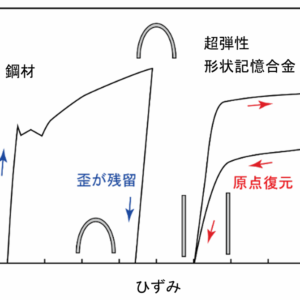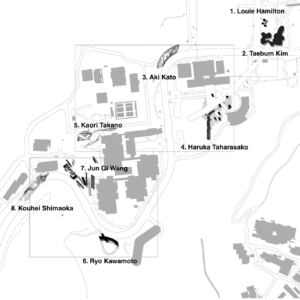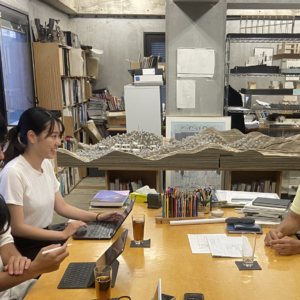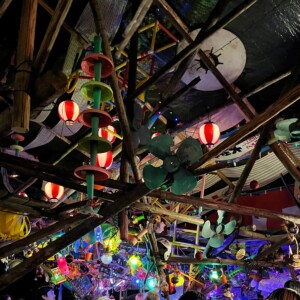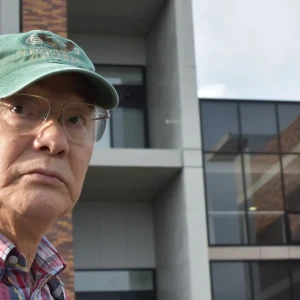
【ダニエル研究室】Paris Tea Pavilion
Comments from students of École Special d’Architecture

For the final part of the workshop, four students from Japan, Fuma, Jiro, Kota, and Taichi (who designed the pavilion), flew all the way to Paris to build the tea pavilion with us: Adrien, Ece, Ha, Henri, Kim, Mariam, Mariken, and Maxence. We were all so glad to finally see the Japanese students at our school after months of working with them online. The first time we actually met was, to be honest, a little awkward, but once we got past the initial introductions, we instantly hit it off, and became friendly with each other right away, despite our cultural differences. We started having conversations about Japan and France, we learned a lot about Japan, about their culture, their architecture, and simply, their lifestyles. After some time, we walked around our school, and admired the Parisian architecture of the 14th arrondissement, all the while talking about French culture, and teaching them some common sentences in French.
The construction took a couple weeks, and we got to build everything from scratch. We first measured and hand-cut wood planks, then assembled and built the whole structure using screws and drills. We all got to participate and worked very efficiently together. Taichi, Fuma, Kota, and Jiro always knew what was the next step, and made sure we understood the project and how to build it. We all worked harmoniously and everyone had a specific “role,” whether it was measuring the wood, carrying the wood, cutting the wood, drilling the wood, etc. A typical day of construction would start around 10am, and would end around 6pm. During those times we would solely focus on building the pavilion. We would always have lunch all together around 1pm, with all the students, Japanese and French, and it was always during those times that we would get to know each other more. We got to learn more about each other’s personal lives, hobbies, aspirations, and so on… Jiro, Fuma, Kota, and Taichi were extremely open minded about French culture, and we were actually surprised. Working with them was so much fun and such an enriching experience, they are all so knowledgeable and hardworking and they would always take the extra mile to make sure that everything was perfect, we all definitely learned a lot from their strong work ethic and perseverance.
After successfully building the tea pavilion and completing the workshop, despite only having known each other for less than a month, we felt like we truly connected with Kota, Fuma, Jiro, and Taichi, and that we had a real bond all together. On the last day, we had a tea ceremony all together in the completed pavilion, and at the end, it was quite sad when we had to say goodbye to each other. This experience is definitely one to remember, and Kota, Fuma, Jiro, and Taichi will always have a special place in our hearts. We thank you again for this wonderful and extremely rewarding experience, we are all very grateful. Hopefully, one day, we can all meet up again, and maybe this time in Japan. Until then, you are always welcome here.
Manh Ha Tran
My personal favorite moment was when we had dinner together on the last day before the Japanese students left. We ate at a French restaurant near the school. After a few glasses of wine, we had some heart-to-heart conversations. I think that was when I bonded the most with them. It was a little sad to say goodbye to them at the end of that night.
Mariam Darboe
Something that I will remember from this experience is the positive and uplifting energy that Taichi, Kota, Fuma, and Jiro had. They were always smiling, and seemed extremely grateful to be here, which was very heart-warming and nice to see.
Mariken Gillet
We made a very nice construction team and the atmosphere was very nice. We were all listening to each other, everything was well organized and the tasks were distributed well: while one team measured and prepared the parts, the other cut and assembled the parts between them. Our international meeting around architecture allowed us to have very interesting discussions.
Lauren Sabah
My favorite moments were when we had online meetings with Taichi and Fuma until 3am, trying to understand each other so that we could work together and make the best project. Those were genuine moments of fun, sharing and exchange that I will not forget.
Yedidia Senoussi
To have been part of this international workshop will always be an unforgettable experience for me. A great moment of exchange between cultures, different working approaches and methods. During this workshop, Mayuko and Kajiura inspired me a lot with their perseverance.
Comments from Instructors

Frank Salama (École Spéciale d’Architecture)
The little story of the tea pavilion… The first month, in June, consisted of a collaboration by Zoom of students residing in two countries (Japan and France) and three different cities (Kyoto, Osaka, and Paris). The collaboration between these students was surprisingly productive. They exchanged ideas with each other during the week and every Wednesday there was a presentation in front of the instructors. There were initially eight teams of four students, then after a first selection there were four teams of eight students left. One project among the four finalists was declared the winner following a vote of teachers and students. In July, the winning team drew up execution plans in order to be able to have the project priced, and obtain the legal authorizations.
In August I took care of the costing and authorization of the project. At the beginning of September, we received the delivery of the wood. Four Japanese students and about fifteen French students then together began construction of the pavilion in the courtyard of ESA. The Japanese students, who had a little experience of wood construction, organized the site perfectly.
The pavilion was inaugurated in mid-September and we could then have a little tea ceremony all together. Finally, the pavilion will stay in the schoolyard for a few months. The workshop was a great new adventure for teachers and students alike. I hope we can repeat this experience.
Noriyuki Hikida (Osaka Sangyo University)
I would like to express my sincere gratitude to Osaka Sangyo University for allowing our students to participate in this international workshop. It was a great experience not only for the students, but also for the faculty members, as we were able to make it this far with warmth and perseverance in the face of many difficulties, such as differences in language and architectural experience. I would like to express my gratitude once again to all the people who have worked so hard to bring us to this point.
The theme of the project was an exciting one: to design a contemporary tearoom in front of the remains of a Le Corbusier design, and it was not just a spatial pavilion, but also a fabrication that entailed a certain amount of limited materials. In particular, the question of how to approach the cultural existence of the tea house was answered differently in each school, and overcoming this question is what made this workshop meaningful.
I hope that these workshops will continue to be held and that we will have the opportunity to participate, and I hope that we can continue to cooperate in the future.
Asako Yamamoto (Osaka Institute of Technology)
First of all, I’m happy and pleased that this workshop was completed with the realized architecture, as to experience the design at 1:1 scale after deep reflection using smaller scale models, or inside a computer, could be the best way to learn about spatial design. Secondly, I think the students were also satisfied with not only the result but also the extraordinary experience of talking and collaborating with foreign students who have different cultural backgrounds and ways to address the problems.
Finally, although all the plans that the teachers made at first didn’t work entirely, because of the difficult situation caused by COVID-19, we could manage to achieve the goal, which was to construct a place to have a cup of tea, even if we had to change many details. I think it is an essential experience for designers who are going to work in society.
All these three points are what I have experienced so far, and what I wanted all the students to discover in some way. So I’m so proud of the outcome and grateful to all the other teachers who made a big effort to finish this project. I would like to visit the construction site as soon as possible!
Kentaro Takeguchi (Alphaville)
The workshop began with the possibility of using the banks of the Seine, where Asile Flottant is located. Fortunately, Kyoei Tea, the famous Morihan tea company that Alphaville had met during the proposal process, agreed to sponsor the project. However, as with Asile Flottant, there were many differences in controlling the construction in a remote and metropolitan city like Paris. Estimates from the carpenters were far behind schedule, and when the order was placed, there was talk of a wood scarcity in September. In the end, I prepared a “Plan B” to reduce the amount of wood by two-thirds, so I activated it with the students and ordered the wood from Marseille (I was participating in another workshop) to Professor Salama by phone.
However, thanks to the students’ good sense of construction, the construction was completed in the expected number of days, without any carpentry training and with the help of a team of French students, which was a good and unexpected thing. On the contrary, with a structure of this size, the designers can put the timber together as if they were modelling it in 3D CAD. The fact that the construction of the architectural space by a human being was pursued as if it were an instinct, makes it a success at the moment.
Participants
Kyoto University
Instructor: Thomas Daniell
Teaching assistant: Anju Kato
Students: Hotaka Iwami, Mayuko Nasu, Wang Guoyi, Taichi Kaga, Jiro Akita, Usaki Tsujimoto
École Special d’Architecture
Instructor: Frank Salama
Teaching assistant: Maxime Font
Students: Louise LeBlanc, Mariken Gillet, Lauren Sabah, Sunny Choukroun, Henri Zenatti, Adrien Bousquet, Maxence Rondel, Ece Gurkan, Kim Gommery, Mariam Darboe, Manh Ha Tran, Yedidia Senoussi, Gravine Lokoto Mbokawa, Louisa Rachedi, Suphi Zencirkiran, Ahmed Khalil
Osaka Sangyo University
Instructor: Noriyuki Hikida
Teaching assistant: Shuji Fujioka
Students: Kota Murayama, Fuma Takakura, Saya Hashimoto, Sayaka Yamazaki, Keita Miyazaki, Takeshi Kajiura, Kyogo Shibata, Thomas Loncq
Osaka Institute of Technology
Instructor: Asako Yamamoto
Student: Yoshihiro Okamoto
Guest critics
Kentaro Takeguchi
Ryo Watada
Support
ADAN (Architectural Design Association of Nippon / Shuhei Endo, Kiyoshi Sey Takeyama)
Sponsor
Sponsor Kyoeiseicha Co., Ltd. Morihan
